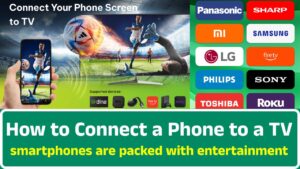How to Connect a Phone to a TV
In today’s world, our smartphones are packed with entertainment — movies, games, photos, presentations, and more. But there are times when a small phone screen just isn’t enough. Connecting your phone to a TV provides a bigger, better viewing experience. There are multiple ways to achieve this, whether you use a cable, wireless technology, or streaming devices.

Why Connect a Phone to a TV?
Connecting your phone to a TV allows you to:
- Watch videos on a bigger screen.
- Show photos and slideshows to friends and family.
- Play mobile games more immersively.
- Stream content from Netflix, YouTube, Prime Video, and other apps.
- Attend video calls or make presentations on a large display.
Basic Requirements
You need:
- A smartphone (Android or iPhone).
- A TV (Smart TV or normal TV with HDMI ports).
- Cables (like HDMI) or wireless devices (like Chromecast, Fire Stick).
- Stable Wi-Fi (for wireless methods).
Wired Connection Methods
HDMI Cable
This offers the most stable and high-quality connection.
You can use:
- USB-C to HDMI adapter for Android phones.
- Lightning to HDMI adapter for iPhones.
Steps:
- Connect your phone to the adapter.
- Attach the adapter to the TV via HDMI cable.
- Switch your TV’s input to the correct HDMI port.
Your phone’s display will instantly mirror on the TV.
USB Cable
Using a USB cable, you can connect a phone and view photos and videos on the TV (like a pen drive).
However, this usually does not mirror your phone’s screen in real-time.
MHL and Slimport
These are older technologies that allowed Android phones to connect to TVs via special adapters.
MHL and Slimport support depends on both your TV and phone models.
Wireless Connection Methods
Screen Mirroring (Miracast)
Most Android phones and some Smart TVs support Miracast technology.
It mirrors your entire phone screen wirelessly over a Wi-Fi Direct connection.
Chromecast
Google’s Chromecast allows you to stream content directly from supported apps like YouTube, Netflix, and Spotify.
You can also mirror your whole Android screen if needed.
Apple AirPlay
For iPhone users, AirPlay lets you wirelessly mirror or cast content to Apple TVs or TVs with AirPlay built-in.
Steps:
- Swipe down to open Control Center.
- Tap Screen Mirroring.
- Select your TV.
DLNA Apps
Apps like BubbleUPnP and LocalCast allow you to stream media from your phone to your TV over a home network.
Connecting Android Phones to TVs
Android phones have native screen mirroring options:
- Smart View (Samsung)
- Cast (OnePlus, Xiaomi, Vivo, Oppo)
By enabling these, your phone will scan for compatible TVs on the same Wi-Fi network and start mirroring easily.
Connecting iPhones to TVs
Options for iPhone users include:
- AirPlay (for Apple TVs or AirPlay-supported TVs).
- Lightning to HDMI adapter (wired method).
- Third-party apps like Replica (to cast via Chromecast).
Connecting to Smart TVs vs Non-Smart TVs
- Smart TVs: Often have built-in Chromecast, Miracast, or AirPlay support.
- Non-Smart TVs: Require external devices like Chromecast, Amazon Fire Stick, or Roku for wireless casting.
Simply plug these devices into the HDMI port, set them up, and cast from your phone.
Using Streaming Devices
- Chromecast: Great for Android and iPhone users.
- Amazon Fire Stick: Supports screen mirroring and app casting.
- Roku: Offers easy mirroring options.
Streaming devices are affordable and easy to install.
Best Apps for Casting
Recommended apps include:
- Google Home (for Chromecast).
- AirScreen (for Fire Stick).
- AllCast and LocalCast (for DLNA streaming).
- Samsung SmartThings (for Samsung TVs).
These apps simplify the process of connecting your phone to your TV.
Troubleshooting Common Issues
- Phone can’t detect TV: Check if both are on the same Wi-Fi network.
- Lagging or delay: Use a 5GHz Wi-Fi band.
- No sound: Ensure correct TV audio settings.
- Adapter issues: Use certified or original cables and adapters.
- Unsupported app casting: Make sure the app allows screen mirroring or casting.
Pros and Cons of Each Method
| Method | Pros | Cons |
|---|---|---|
| HDMI Cable | Best quality, no lag | Needs cable/adapters |
| Wireless | Convenient, portable | May lag without good Wi-Fi |
| Chromecast | Affordable, app-friendly | Requires setup |
| AirPlay | Smooth for iOS users | Limited to Apple devices |
Tips for a Better Experience
- Use 5GHz Wi-Fi instead of 2.4GHz for faster and stable casting.
- Keep your TV’s firmware updated.
- Close unnecessary background apps for better performance.
- Use good quality HDMI cables.
- Place devices closer together to avoid signal loss.
The Future of Phone-to-TV Technology
Advances like Wi-Fi 7, USB 4.0, and integrated casting support in newer TVs will make screen mirroring even smoother.
Emerging tech like Augmented Reality (AR) may soon blend phones and TVs for next-gen media experiences.
Conclusion
There are many ways to connect your phone to your TV depending on what devices you have and your preferences.
Wired options like HDMI give stable performance, while wireless methods like Chromecast, AirPlay, and Smart View provide flexibility.
No matter your phone model — Android or iPhone — or TV type — Smart or non-Smart — you can easily enjoy your favorite content on a larger screen with just a few simple steps!
